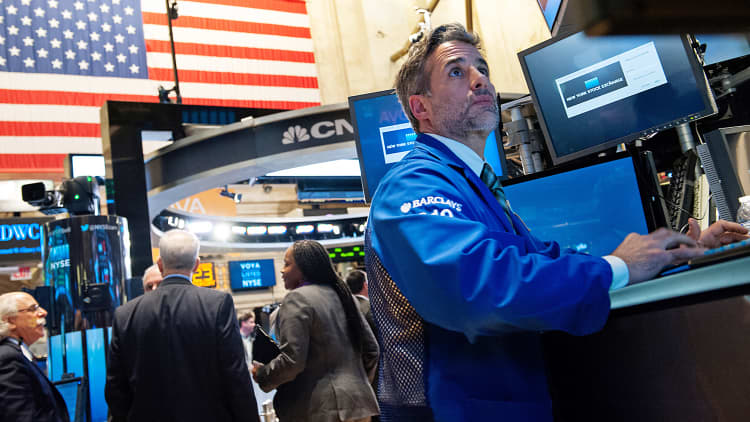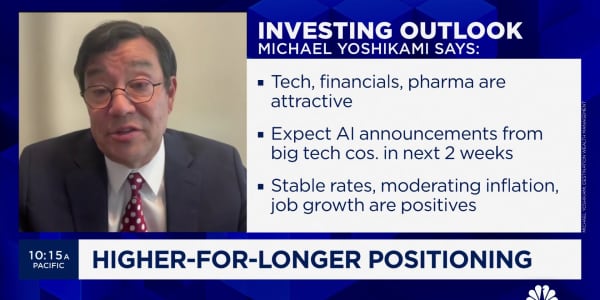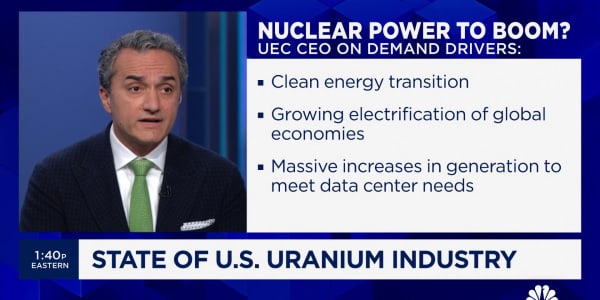
The stock market is acting as if the mid-October swoon never happened, despite a general—and fairly recent—sense of caution on Wall Street.
Strategists at JPMorgan and Bank of America Merrill Lynch released reports this week that, while overall bullish, told clients to prepare for more muted returns. Individual investors, though, don't seem to be listening, with sentiment indicators running strongly positive.
Caution hasn't been evident over the past week or so in the markets, which ripped higher after taking a hit from a variety of factors: Ebola worries, a significant euro zone economic slowdown and uncertainty about the rate of future Federal Reserve monetary policy.
Through Thursday trading, the picked up 4.73 percent, the Dow Jones Industrial Average 3.78 percent and the Nasdaq tech gauge 5.58 percent.
JPMorgan, though, said the move was predictable: The market was in "extreme oversold" territory when looked at from a technical standpoint, with a "bullish turn" expected "until indicators normalize." Strategist Jason Hunter said the rally could continue until the S&P 500 reaches the 1,970-1,986 range. At the top end, that's a gain of another 1.85 percent from Thursday's close.
Read MoreUS stocks and sectors to watch after NY Ebola case
Then, things start to get dicey, with volatile conditions that Hunter expects to last well into 2015.
"The increased volatility over the summer and fall months adds conviction to our longer-term outlook," he said. "We have been forecasting a period of consolidation within the longer-term bull market. "Our base case view calls for a broad range to carry into mid-2015."
Read MoreHere's where JPMorgan Private Bank is investing
That forecast is made a bit more interesting in that it represents a departure for JPMorgan, which had been relentlessly bullish under former strategist Thomas Lee, who recently departed and co-founded Fundstrat Global Advisors.
However, it meshes with a general feeling that, while the market is heading higher, the easy money has been made and investors are going to need to be more selective against a changing backdrop.
Michael Hartnett, chief investment strategist at Bank of America Merrill Lynch, said the landscape for 2014-2015 is one of "significantly lower, more volatile, but still positive market returns" with "leadership slipping away from the 'ZIRP winners' .. to the 'ZIRP losers.'"
By "ZIRP," Hartnett means the Fed's zero interest rate policy, which has been in place for nearly six years and has accompanied an aggressive quantitative easing program that has seen the central bank's balance sheet push past $4.5 trillion.
Read MoreI got 'bear market' wrong: Gartman
The "ZIRP winners," in this view, have been gold, high-yield bonds, carry-trades playing lower-yielding currencies off higher-yielding ones, and small-cap stocks. Replacing them as market leadership will be the U.S. dollar, banks, and volatility plays. BofAML's best bets are on an appreciating dollar and real estate, against commodities, and stocks over bonds and credit.
Amid the cautious tones from Wall Street, however, are retail investors, who have remained surprisingly buoyant.
This week's American Association of Individual Investors survey showed bullishness—a measure of those who think stocks will be higher in six months—at 49.7 percent. That's the highest since late-August and the 10th time in the last 11 weeks that the measure is above its historical norm, despite market tumult that has only recently seen the Dow blue chips turn positive for the year. The S&P 500 stock index has fallen 2.4 percent over the past month.
Bearishness among AAII respondents was even more remarkable, tumbling 11.2 percentage points to 22.5 percent.
A similar dichotomy also is present in fund flows: Investors put a net $1.1 billion into mutual funds—generally a good proxy for retail investors—while pulling $8.2 billion from exchange-traded funds, which are considered a better measure of short-term trader preference.
Read MoreDavid Tepper takes short position against the euro
Strong shifts in sentiment are often good contrary indicators, though it looks for now like the bulls are in control.
Mom-and-pop investors "viewed the recent downward volatility as a buying opportunity," Charles Rotblut, the AAII Journal editor, said in a narrative that accompanied the survey results. "The pullback in the S&P 500 and the correction in the Russell 2000 made valuations more attractive and helped to alleviate concerns about stock prices having moved too far upward too fast."







